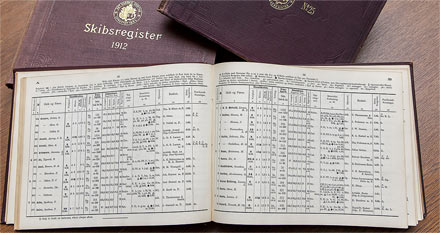
Stiftelsen Det Norske Veritas dates back to 1864, when it was officially founded in Oslo (then Christiania) as a membership organization, with the aim of providing “reliable and uniform classification and taxation of Norwegian ships”. Members of the classification society were Norway’s mutual marine insurance clubs, which joined forces to establish uniform rules and procedures for assessing the risk of underwriting individual vessels. Since then, Det Norske Veritas (DNV), has developed its business globally and in many other areas.
The history of Stiftelsen Det Norske Veritas and DNV is inseparable.
Going back to 1864, the creation of Det Norske Veritas was a response to an emerging, nationwide market for marine insurance at a time when the Norwegian shipping industry was experiencing rapid growth and breaking out of its previous local confinement.
The DNV-classed merchant fleet increased rapidly, and agents, and later permanent surveyors, were appointed in a number of countries to serve Norwegian vessels abroad. Steamships were introduced in the 1870’s, dramatically changing the classification business and the work and competence required of surveyors.
Society became an increasingly demanding stakeholder in a dominantly liberal and private industry. Following the Titanic disaster in 1912, safety at sea became the subject of increasing public concern, and international classification societies played an important part in discussions on ship safety.
After the First World War, the transition from sailing ships to steamers was complete, and there was a fundamental change in technology and skills needed for the classification industry. The rules were too old and were no longer in harmony with modern shipbuilding methods of the time. Between 1920 and 1940, DNV was technically independent, and a new culture was established, giving priority to engineering, construction and design.
Georg Vedeler, appointed managing director of DNV in 1951, introduced a scientific approach to ship construction. His vision was to build safer ships in a more efficient way, introducing scientific competencies and skills into the organization. At this time the fleet was still predominantly Norwegian, but internationalization was taking off.
DNV entering the oil and gas business
From the perspective of competence and impact, DNV was well prepared when commercial oil was found in the North Sea. The firm came to play an important role in this new industry within Norway as an advisor for both authorities and oil companies. Verification, inspection and risk management services were developed and introduced based on DNV’s experience and technological competence within the maritime industry. Later, this core competence and independent role from the maritime industry has been applied to other industry sectors.
The world’s first pipeline rules were published by DNV in 1976, setting a world standard. Starting in the early 1970’s, DNV was offered most of the building supervision and inspection assignments on the Norwegian continental shelf. Offshore floating rigs and supply vessels also became a new and strong segment for DNV in traditional ship classification.
Internationalization and diversification
In 1977, wind energy was introduced as a new business segment. For DNV, this and other climate-friendly service areas represented new opportunities for organizational growth based on a strong and research-driven technology base. New rules were developed, and certification of land-based and offshore wind turbines became an important growth area for DNV. Despite periods of setbacks and decline in shipping and oil, DNV was able to focus on growth and internationalization as the twentieth century came to a close.
In the late 1980’s and early 1990’s the new industry of management system certification based on ISO-standards emerged, and DNV took a global position in this expanding business.
Alliances, mergers, and acquisitions became a strong strategic driver for DNV. In 2005, DNV acquired CCT (US), a specialist in corrosion control and pipeline and plant integrity analyses, and followed this with the acquisitions of Global Energy Concepts (US) in 2008 and US-based Behnke, Erdman and Whitaker (BEW) in 2010. To support prevailing strategies within the new climate-friendly service fields, DNV established its Sustainability Centre in Beijing in 2009 and a Clean Technology Centre in Singapore in 2010.
Strategically adapting to the challenges of climate change, and following the development of the Kyoto Protocol agreement, DNV was accredited by the UN Framework Convention on Climate Change for its clean development mechanism (CDM) in 2005. By 2006, DNV had approximately 50 per cent of the global market for emission reductions verification.
A broader set of assurance services to the energy sector
In 2012, DNV and KEMA joined forces to create a world-leading consulting, testing and certification company for the global energy sector. KEMA was established by the Dutch electrical power industry in 1927 and was subsequently developed into a high-profile international brand that provided services to the global energy sector, including renewable energy, carbon reduction and energy efficiency, power generation, transmission and distribution.
DNV merging with GL
DNV GL became operational on September 12, 2013 after a long courtship between DNV and Germany-based Germanischer Lloyd (GL). That included numerous relationship-building advances and discussions about co-operation and mergers that took place in 1867, 1986, 2000 and again in 2006. The merged DNV GL became the world’s largest ship classification society and a globally leading energy certification and consultancy provider, and one the world’s leading certification bodies to a wide range of industries, including, food and beverages, automotive, and healthcare. Stiftelsen Det Norske Veritas became the majority owner of DNV GL with Mayfair (the previous owner of GL) owning 36.5% of the shares in DNV GL.
Stiftelsen Det Norske Veritas sole owner and DNV GL changes name to DNV again
However, in December 2017, Stiftelsen Det Norske Veritas assumed full ownership of DNV GL, buying the minority shareholding from Mayfair. In 2021, DNV GL was renamed DNV.
